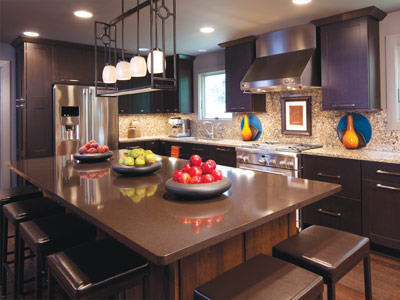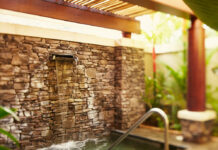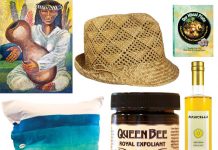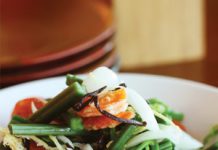Story by Rick Cowan
 The big three of any kitchen remodel, in terms of expense and design, are the cabinetry, appliances and countertops. Cabinetry typically sets the tone, appliances the functionality, and countertops the texture, color and design statement.
The big three of any kitchen remodel, in terms of expense and design, are the cabinetry, appliances and countertops. Cabinetry typically sets the tone, appliances the functionality, and countertops the texture, color and design statement.
For natural beauty and durability, granite still sets the standard, and remains the most common countertop material. One reason is the wide selection this natural stone has to offer, from bold colors with lots of motion and variation, to more uniform tones and patterns. You can also add texture by selecting a honed or brushed finish.
Choosing a stone-supply company that also fabricates and installs countertops creates a more seamless process. Be sure to let the fabricator know you want to see the layout of the countertop before fabrication begins, so you know how the patterns of the stone will flow, and where the seams will go. Some stones have wonderful features that you may want to spotlight, while less impressive sections can be where the sink or cooktop cutouts go.
Care and maintenance of granite is fairly simple: Dust with a microfiber cloth; clean with warm water. Once a week, wipe with a damp cloth and a stone cleaner formulated with a neutral pH. Never use harsh chemicals or abrasive cleaners. These can scratch and pit the stone. Reseal the countertop when water splashed on the surface no longer beads, typically once a year, depending on use. Contact a stone-care professional to repair stains or other damage.
Beyond the classic beauty of natural stone, today’s manufacturers are introducing exciting new materials, including some that have a smaller carbon footprint.
Lumigraf makes a resin-based, faux material called Lumi-Onyx that looks like real onyx, marble or alabaster. It’s lightweight enough to be used for backsplashes and walls, and can be backlit to create a wonderful, warm glow. It is durable and easy to maintain, and although it’s made from a petroleum-based resin, Lumi-Onyx isn’t quarried like natural stone, which requires a tremendous amount of water and energy.
IceStone takes environmental friendliness even further. Made from recycled glass and concrete, IceStone carries a Cradle-to-Cradle certification: 100 percent of the product can be recycled again. It comes in amazing colors, and can be fabricated just like granite. It also needs to be maintained much like granite, with similar sealing or waxing.

Cambria, a crushed quartz combined with resin, is very durable and requires no maintenance—in fact, stone sealers will damage the material. Avoid harsh chemicals or cleaners like bleach, and your Cambria countertop will look beautiful for years.
Perhaps the most surprising countertop material is made from 100 percent post-consumer recycled paper, petroleum-free resin and natural pigments. Known by brand names PaperStone and Richlite, it comes in handsome earth colors, is durable and stain resistant, and absorbs virtually no water. Surface cuts, scratches or mars can be easily sanded or rubbed with an abrasive pad and treated with PaperStone or Richlite finish. It’s strong enough for cantilevered designs up to eighteen inches.
Want a rustic, artistic look? Consider concrete. It’s durable, has a very small carbon footprint, and these days comes in wonderful colors. You can also add aggregates during fabrication. I’ve seen coins, clockworks, shells, beach glass and handprints placed in countertops. Just be aware that you won’t really know how the aggregates will look until the countertop is finished. Concrete also needs more regular sealing; ask the fabricator to explain the different options.
Stainless steel is a great material with a classic look. I have reused stainless-steel countertops in kitchens we were remodeling, having a fabricator alter them to fit the new design and selecting contrasting countertops for other areas. Stainless steel is outstanding for prep areas and islands. It will scratch, but over time this turns into a wonderful patina.
My favorite accent material is glass. I have used it for bar tops, winged shelving, and even a cooktop counter. Glass can scratch, but is durable and easy to maintain. There are also some wonderful recycled materials like Re-Glass, which is made from reclaimed glass and polymers. Available in numerous colors and styles, these are custom pieces and require specific measurements for fabrication.
Can’t decide? Think about combining countertop materials, or incorporating other finishes in your kitchen. I have used granite and wood, concrete and travertine, stainless steel and stone. Blending materials adds interest and texture to a kitchen design.





